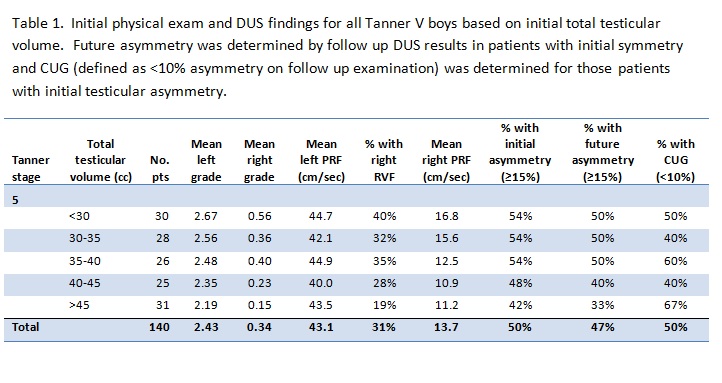|
Back to Fall Congress
Significance of Total Testicular Volume as a Prognostic Factor in the Adolescent Varicocele
Jason P. Van Batavia, MD, Julia Finkelstein, MD, Scarlett Tohme, BA, Kenneth I. Glassberg, MD.
Division of Pediatric Urology, Morgan Stanley Children's Hospital of New York-Presbyterian Hospital, Columbia University, New York, NY, USA.
BACKGROUND: Lower total testicular volume (TTV) has been recently shown to be associated with impaired semen quality in adults with left varicoceles (Chen, Urology 2012). In fact, some have hypothesized that it may be a more important parameter than percent testicular asymmetry as regards future fertility in adolescents. Since semen analysis is not readily available in adolescent boys with varicoceles, testicular measurements with Doppler ultrasound (DUS) and various cut-offs for asymmetry are often used as a surrogate. We sought to analyze TTV in Tanner V boys with varicoceles to determine if it has any potential value in decision making.
METHODS: All Tanner V boys in our IRB-approved Pediatric Varicocele Database with DUS reports were reviewed. TTV was based on DUS findings and boys were divided into TTV groups based on arbitrary cut-off values to give even distribution of patients in each group (ie so each group had 25-30 patients). Relationships between TTV group and initial left varicocele grade, presence and grade of right varicocele, left peak retrograde flow (PRF), presence of right retrograde venous flow (RVF), right PRF if present, and testicular asymmetry (≥15%) were analyzed. For patients with asymmetry, catch-up growth (CUG) was determined.
RESULTS: In total, 140 boys (mean age 17.1 yrs, range 13.8-20.1) were included. Boys with lower initial TTV were more likely to have higher left varicocele grade and higher incidence of subclinical or palpable varicocele on the right side (table 1). There was a trend towards less initial testicular asymmetry in the higher TTV groups and these groups also had less future asymmetry and more CUG on follow up. Interestingly, amongst boys who underwent varicocelectomy, those with higher TTV were more likely to have CUG after surgery.
CONCLUSIONS: Tanner V boys with lower TTV are more likely to have higher grade left varicoceles and an identifiable right varicocele by both palpation and RVF. In addition, lower TTV was associated with higher initial testicular asymmetry and a higher likelihood of future asymmetry in those presenting with initial symmetry. Low TTV (<40 cc) in Tanner V boys with a left varicocele may turn out to be an additional indicator for surgery especially if a right varicocele with high PRF is present, the combination of which was seen in 16% of the patients studied.

Back to Fall Congress
|


